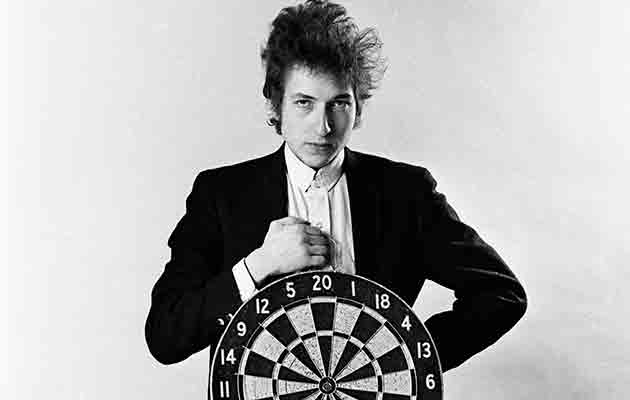In Chronicles Volume 1, Bob Dylan recalled the state of contemporary music in the earliest days of his career. “Things were pretty sleepy on the Americana music scene in the late ‘50s and early ‘60s,” he wrote. “Popular radio was sort of at a standstill and filled with empty pleasantries. It was years before The Beatles, The Who or the Rolling Stones would breathe new life and excitement into it. What I was playing at the time were hard-lipped folk songs with fire and brimstone servings.”
Dylan’s first four albums – and his early reputation – were built on those “hard-lipped folk songs”. What happened next, of course, was a slow process of turning electric that began on Bringing It All Back Home and ran through Highway 61 Revisited and Blonde On Blonde. It is a remarkably combative period – even by Dylan’s standards – as the footage of his controversial performances at the Newport Folk Festival and Manchester Free Trade Hall attest. But if our perception of Dyan’s electric transformation has so far been filtered through the audience response on the ground, so to speak, the latest installment in his ongoing Bootleg series offers us a glimpse into the working processes that enabled him to progress from an acoustic to an electric.
The Cutting Edge 1965 – 1966: The Bootleg Series Vol. 12 presents Dylan’s transformation as an often tentative, exploratory experience. The disc devoted solely to 20 alternative takes of “Like A Rolling Stone”, for instance, demonstrates on an pain-staking forensic level the events of June 1965, as Dylan pushed the limits of his ingenuity. There is a fascinating counter-factual here – what if, for instance, Dylan had released Take 7? How different would Dylan’s career have been; or indeed how might the history of popular music become altered?
Listening to the various versions of “Like A Rolling Stone” – a waltz-time version, a slow version, and on through different versions – you sense Dylan’s creative trajectory as he figures out the song’s parameters; and also his frustrations. Essentially, Dylan and his band – Mike Bloomfield (guitar), Joe Macho Jr (bass), Bobby Gregg (drums), Al Kooper (organ), Paul Griffin (piano) and Bruce Langhorne (tambourine) – nail the song on Take 4. Dylan, however, wants to keep working through takes, restlessly trying to capture something else, something just out of view. “Why can’t we get that right, man?” he asks producer Tom Wilson, clearly exasperated after Take 13.
Further down the rabbit hole, and the CD also comes with the song’s stem tracks – Bloomfield’s guitar, Dylan’s guitar and vocals, drum and organ, bass and piano. It’s possible to truffle out fascinating details – the way Bloomfield leans into the chorus, how Dylan seems to stop playing rhythm guitar when he’s singing, or simply acknowledge the cosy, analogue vibes of Columbia Records’ Studio A.
It is, really, a lot of figurative head scratching and figuring things out. From Bringing It All Back Home, there’s a jazzy, acoustic version of “Subterranean Homesick Blues”, a Delta blues rendition of “Outlaw Blues” and “Mr Tambourine Man” recorded with a drummer. “Those drums are driving me mad!” yelps Dylan. From Highway 61, there’s a ferocious version of “It Takes A Lot To Laugh…”, a dreamy version of “Tom Thumb’s Blues” that sounds like something off the third Velvet Underground album (it’s that discreet, spidery Sterling Morrison-style guitar, I think), and two different takes of the title track. One has a similar pounding momentum as “Run Run Run” from the first Velvets album while a second, lighter version finds Dylan messing around with Al Kooper’s police whistle. Such bants! There is also a terrific take on “Desolation Row” performed at the piano.

Meanwhile, for Blonde On Blonde, we are privy to the New York sessions from October 1965 in New York with The Hawks. Most of these didn’t make it out of the studio, of course, as Dylan instead headed to Nashville to record the greater part of the album. Here, though, we can hear some of Dylan’s earliest work with The Hawks, including energetic takes on “Visions Of Johanna”, “One Of Us Must Know (Sooner Or Later)” and the dropped “She’s Your Lover Now”. There is also a warm, acoustic “Stuck Inside Of Mobile…” and more Bob comedy gold: a version of “Leopard Skin Pillbox Hat” augmented with items found in the back of Kooper’s organ, like car horns.
All told, The Cutting Edge 1965 – 1966 feels like a vital part of Dylan’s history. It isn’t just the revelations behind Dylan’s working practices that are so informative; but the way that Dylan as a person emerges from the proceedings. The moments of humour, the mistakes and accidents documented here in between the hard work and flashes of brilliance all add valuable shading to this beguiling portrait of Dylan as he enters his first imperial phase.
Follow me on Twitter @MichaelBonner
The History Of Rock – a brand new monthly magazine from the makers of Uncut – a brand new monthly magazine from the makers of Uncut – is now on sale in the UK. Click here for more details.
Uncut: the spiritual home of great rock music.


